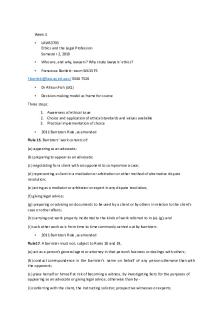Lecture notes, summary PDF

| Title | Lecture notes, summary |
|---|---|
| Author | Jack Chou |
| Course | Research Methods in Psychology |
| Institution | University of Victoria |
| Pages | 2 |
| File Size | 33 KB |
| File Type | |
| Total Downloads | 56 |
| Total Views | 158 |
Summary
- Psychology 201 Chapter 11.docx
- UNIT 4 psy 201.docx...
Description
Psychology 201 Chapter 11~12 Level- the particular value of the independent variable True experiment- Researcher has complete control over all aspects of research Ceiling- Interaction in which effect of one independent variable is smaller when paired with higher levels of another independent variable Two-Conditions Between-Subjects- research design in which each participant experiences only one of two levels of independent variable Multiple-Conditions Between-Subjects- research design in which each participant experiences only one of multiple levels of independent variable Factors- the independent variables in an experiment Multiple-Conditions Within-Subjects- research design in which each participant experiences each other multiple levels of independent variable One-Group Pretest-Posttest- bad research design that measures single group on dependent variable before and after treatment Non-equivalent- control group is selected from different population than experimental group Main- effect of one independent variable averaged over all levels of another independent variable Block Randomization- each condition in within-subjects design occurs in random order within blocks comprised of every condition Interaction- effect of one independent variable depends on level of another independent variable Condition- a group or treatment in an experiment Antagonistic- interaction in which two independent variables reverse each other's effect Counterbalance- each condition in within-subjects design occurs in each ordinal position Mixed- factorial design with between-subjects variable and within-subjects variable Latin Square- each condition in within-subjects design occurs in different order for each participant Order Effect- ordinal position of condition in within-subjects design affects dependent variable Synergistic- interaction in which two independent variables enhance each other's effect
Factorial- research design that involves all combinations of at least two levels of two or more independent variables One-Group Posttest-Only- bad research design that measures single group on dependent variable after treatment. Sequence Effect- interaction due to ordinal position of conditions in within-subjects design affects dependent variable Two-Conditions Within-Subjects- research design in which each participant experiences each of two levels of independent variable Reverse Counterbalancing- each condition in within-subjects design occurs first in order and then in opposite order...
Similar Free PDFs

CHEM3123 Lecture Summary Notes
- 31 Pages

SAR - Lecture notes Summary
- 2 Pages

Summary of lecture notes
- 4 Pages

Lecture notes, summary
- 2 Pages

Summary Learning Lecture notes
- 15 Pages
Popular Institutions
- Tinajero National High School - Annex
- Politeknik Caltex Riau
- Yokohama City University
- SGT University
- University of Al-Qadisiyah
- Divine Word College of Vigan
- Techniek College Rotterdam
- Universidade de Santiago
- Universiti Teknologi MARA Cawangan Johor Kampus Pasir Gudang
- Poltekkes Kemenkes Yogyakarta
- Baguio City National High School
- Colegio san marcos
- preparatoria uno
- Centro de Bachillerato Tecnológico Industrial y de Servicios No. 107
- Dalian Maritime University
- Quang Trung Secondary School
- Colegio Tecnológico en Informática
- Corporación Regional de Educación Superior
- Grupo CEDVA
- Dar Al Uloom University
- Centro de Estudios Preuniversitarios de la Universidad Nacional de Ingeniería
- 上智大学
- Aakash International School, Nuna Majara
- San Felipe Neri Catholic School
- Kang Chiao International School - New Taipei City
- Misamis Occidental National High School
- Institución Educativa Escuela Normal Juan Ladrilleros
- Kolehiyo ng Pantukan
- Batanes State College
- Instituto Continental
- Sekolah Menengah Kejuruan Kesehatan Kaltara (Tarakan)
- Colegio de La Inmaculada Concepcion - Cebu










